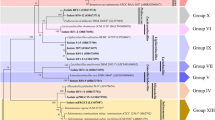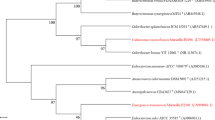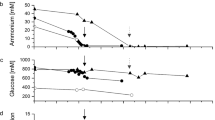Abstract
THE sulphate-reducing bacteria at present available in pure culture are Desulphovibrio desulphuricans, its aestuarii variant1, the thermophilic Clostridium nigrificans (earlier known as D. thermodesulphuricans 2) and the new species D. orientis 3. The species D. rubentschickii and its variant anomalous, able to utilize acetate and/or butyrate4, have so far defied re-isolation.
This is a preview of subscription content, access via your institution
Access options
Subscribe to this journal
Receive 51 print issues and online access
$199.00 per year
only $3.90 per issue
Buy this article
- Purchase on Springer Link
- Instant access to full article PDF
Prices may be subject to local taxes which are calculated during checkout
Similar content being viewed by others
References
Littlewood, D., and Postgate, J. R., J. Gen. Microbiol., 17, 378 (1957).
Campbell, L. L., Frank, H. A., and Hall, E. R., J. Bact., 73, 516 (1957).
Adams, M. E., and Postgate, J. R., J. Gen. Microbiol., 20, 252 (1959).
Baars, J. K., “Over Sulfaatreductie door bacteriën” (Meinema: Delft, 1930).
Postgate, J. R., J. Gen. Microbiol., 14, 545 (1956).
Butlin, K. R., Adams, M. E., and Thomas, M., J. Gen. Microbiol., 3, 46 (1949).
Author information
Authors and Affiliations
Rights and permissions
About this article
Cite this article
POSTGATE, J. A Diagnostic Reaction of Desulphovibrio desulphuricans . Nature 183, 481–482 (1959). https://doi.org/10.1038/183481b0
Issue Date:
DOI: https://doi.org/10.1038/183481b0
This article is cited by
-
Desulfovibrio mangrovi sp. nov., a sulfate-reducing bacterium isolated from mangrove sediments: a member of the proposed genus “Psychrodesulfovibrio”
Antonie van Leeuwenhoek (2023)
-
A novel sulfate-reducing and nitrogen-fixing bacterium Fundidesulfovibrio soli sp. nov., isolated from paddy soils
Archives of Microbiology (2023)
-
Fundidesulfovibrio agrisoli sp. nov., A Nitrogen-Fixing Bacterium Isolated from Rice Field
Current Microbiology (2023)
-
Desulfotomaculum tongense sp. nov., a moderately thermophilic sulfate-reducing bacterium isolated from a hydrothermal vent sediment collected from the Tofua Arc in the Tonga Trench
Antonie van Leeuwenhoek (2013)
-
New sulfate-reducing bacteria isolated from Buryatian alkaline brackish lakes: description of Desulfonatronum buryatense sp. nov
Extremophiles (2013)
Comments
By submitting a comment you agree to abide by our Terms and Community Guidelines. If you find something abusive or that does not comply with our terms or guidelines please flag it as inappropriate.



